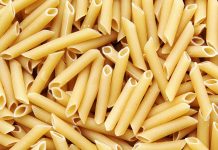Material and methods
 The study foresees the acquisition of technical-scientifi c information on some characteristics of the materials and the interaction of them with the must and the wine. In particular, the tests concerned the evaluation of three types of bentonites produced by Azienda Dal Cin: two of them, Superbenton (in powder) and Top Gran DC (granular), used in oenology for a long time, and a third one called “experimental clay” with a high content in montmorillonites. The tests were prepared on laboratory scale and included the use of two white wines both deriving from the variety Chardonnay, but having very different characteristics: product 1, taken after 6 months’ refi ning on the lees, is characterized by a high content in proteins, and product 2, a young wine, taken immediately after the alcoholic fermentation, has a reduced content in proteins. The clays have been used after re-hydration in a water volume ten times their weight, as summarized in the scheme of figure 1. The following parameters were evaluated on all samples:
The study foresees the acquisition of technical-scientifi c information on some characteristics of the materials and the interaction of them with the must and the wine. In particular, the tests concerned the evaluation of three types of bentonites produced by Azienda Dal Cin: two of them, Superbenton (in powder) and Top Gran DC (granular), used in oenology for a long time, and a third one called “experimental clay” with a high content in montmorillonites. The tests were prepared on laboratory scale and included the use of two white wines both deriving from the variety Chardonnay, but having very different characteristics: product 1, taken after 6 months’ refi ning on the lees, is characterized by a high content in proteins, and product 2, a young wine, taken immediately after the alcoholic fermentation, has a reduced content in proteins. The clays have been used after re-hydration in a water volume ten times their weight, as summarized in the scheme of figure 1. The following parameters were evaluated on all samples:
- deproteinizing capacity of the material, stated through an analysis of the proteins and their fractionation by molecular weight, by using techniques of high performance liquid chromatography;
- interaction of bentonite with odorous molecules, by monitoring the main markers of he fermentative aroma of wine through chromatography in gaseous phase.
Results
 The percent reduction of the protein in comparison with the content of the sample after static sedimentation was calculated to evaluate the deproteinisation done by the clays. Figure 2 shows the data of the percent reduction for every dose of bentonite used in the case of wine 2, the young Chardonnay. It is bentonite Top Gran DC that in terms of global reduction gives the best performances at all dosages of treatment. By using a quantity of 50 g/hl, the proteinic reduction is higher that that attainable with other products at the dosage of 100 g/hl. At the maximum level of treatment, experimental clay and Superbenton show the same effectiveness, while at lower levels (20 and 50 g/hl) the experimental preparation has a slightly higher deproteinisation capacity. It is worth observing that the proteins with a molecular weight between 17,000 and 1.350 Daltons, representing the most important fraction, mirror the effectiveness of the treatment in terms of total proteins. On the contrary, wine 1 showed less important deproteinisation even at the dose of 100 g/hl. This fact can be due to a “matrix effect” that in wine concerns the type and the charge of the proteins involved, for instance the mannoproteins released by the yeasts during the refi nement of the wine on the yeasts. Besides, in Chardonnay 1 there is a higher level of protector colloids and a higher pH, which could interfere with the action of bentonite. As to the interaction with the odorous substances of fermentative origin, all volatile substance determined have been gathered in three homogeneous families including respectively the compounds with fruity/floral characteristics, vegetal/herbaceous and sweet/juicy notes. Therefore the wines object of the experiment were subdivided according to these characteristics: wine 2, the youngest Chardonnay, is a product with freshness notes of the scents; wine 1, more structured, besides a smaller fraction of fruity and herb aromas, presents a more accentuated juicy and sweet note. Examining the percent reduction in comparison with the sample, it can be observed that the removal of the herbaceous/vegetal notes (table 1) is higher through Top Gran DC bentonite in both wines, even if used at low dosage. As for the volatile compounds contributing to the characteristics of juiciness and sweetness of wine (table 2), the reduction to the dose of 100 g/hl gives way to very varied progresses in both products and it is more accentuated in wine 2.
The percent reduction of the protein in comparison with the content of the sample after static sedimentation was calculated to evaluate the deproteinisation done by the clays. Figure 2 shows the data of the percent reduction for every dose of bentonite used in the case of wine 2, the young Chardonnay. It is bentonite Top Gran DC that in terms of global reduction gives the best performances at all dosages of treatment. By using a quantity of 50 g/hl, the proteinic reduction is higher that that attainable with other products at the dosage of 100 g/hl. At the maximum level of treatment, experimental clay and Superbenton show the same effectiveness, while at lower levels (20 and 50 g/hl) the experimental preparation has a slightly higher deproteinisation capacity. It is worth observing that the proteins with a molecular weight between 17,000 and 1.350 Daltons, representing the most important fraction, mirror the effectiveness of the treatment in terms of total proteins. On the contrary, wine 1 showed less important deproteinisation even at the dose of 100 g/hl. This fact can be due to a “matrix effect” that in wine concerns the type and the charge of the proteins involved, for instance the mannoproteins released by the yeasts during the refi nement of the wine on the yeasts. Besides, in Chardonnay 1 there is a higher level of protector colloids and a higher pH, which could interfere with the action of bentonite. As to the interaction with the odorous substances of fermentative origin, all volatile substance determined have been gathered in three homogeneous families including respectively the compounds with fruity/floral characteristics, vegetal/herbaceous and sweet/juicy notes. Therefore the wines object of the experiment were subdivided according to these characteristics: wine 2, the youngest Chardonnay, is a product with freshness notes of the scents; wine 1, more structured, besides a smaller fraction of fruity and herb aromas, presents a more accentuated juicy and sweet note. Examining the percent reduction in comparison with the sample, it can be observed that the removal of the herbaceous/vegetal notes (table 1) is higher through Top Gran DC bentonite in both wines, even if used at low dosage. As for the volatile compounds contributing to the characteristics of juiciness and sweetness of wine (table 2), the reduction to the dose of 100 g/hl gives way to very varied progresses in both products and it is more accentuated in wine 2.



